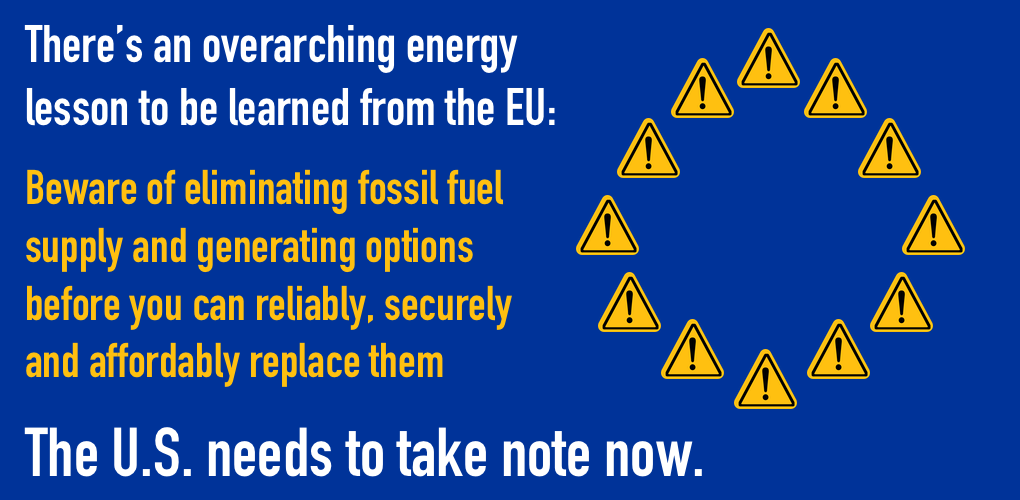
Reembrace American Energy Abundance
It has taken the rumble of Russian tanks to remind us of the importance of energy security. While economic sanctions have touched nearly every dimension of the Russian economy, Russia’s energy sector remains largely a bridge too far, a testament to the importance of Russian oil, gas, uranium and coal to global energy markets, and particularly to European consumers. As Bloomberg’s energy and commodities columnist, Javier Blas, observed, in the days following the Russian invasion, European buyers have bought more – not less – Russian gas.
European energy insecurity is the accumulation of policy choices governments are now scrambling to correct. As much as the West might like to sever its dependence on Russian energy and commodities, doing is an all but impossible task in the near-term. Even the U.S. – the world’s largest oil and gas producer – is importing a half million barrels of Russian oil and refined products per day, importing Russian uranium to generate nuclear power and at times relying on Russian natural gas to keep the heat and lights on in New England. Russia’s energy leverage is immense and now is the time to take the critically important steps – even if they are to be painful – to break it.
As President Biden is likely to layout in his State of the Union address, there’s much the U.S. can do with energy to help our European allies. But there’s also much we can and should learn from their missteps and the irresponsible way they have gone about managing the energy transition.
Learn from Europe’s Missteps
There’s an overarching energy lesson to be learned: beware of eliminating fossil fuel supply and generating options before you can reliably, securely and affordably replace them. Europe’s waning investment in its own natural gas supply and, notably, its rush to close its coal capacity before building a reliable alternative have left it stunningly dependent on Russian energy. In fact, Europe is now more reliant on Russian natural gas today than it was before the Russians annexed Crimea in 2014.
It’s fair to ask what Europe’s energy security – and energy costs – might be if it had used its coal fleet as a bridge in the energy transition and not Russian natural gas. Europe would have a far more diverse dispatchable energy mix, a far more secure supply of energy and robbed the Kremlin of considerable geopolitical leverage. Already, research groups are working through scenarios to map out how Europe can slash or even eliminate its use of Russian natural gas by next winter. While U.S. LNG will almost certainly have an even larger role to play, don’t overlook the importance of U.S. coal.
According to policy experts at one leading European economics research group, cutting Europe’s reliance on Russian gas is possible by next winter but the key is a substantial reduction in European gas demand. Delaying nuclear phaseouts, rapidly deploying heat pumps and solar PV installations can all help but far and away the largest reduction in demand can come from gas-to-coal switching. In a remarkable turn of events, even the German Greens are open to it, saying, “There are no taboos,” as we evaluate what it will take to break Germany’s reliance on Russian energy imports.
Of course, Europe is painfully dependent on Russian coal as well. According to Argus, Russian coal exports to Germany, the Netherlands and Belgium made up 67% of the region’s total coal imports from January to November of 2021. Replacing Russian gas and coal is an extraordinary challenge but it’s just what the U.S. and its global partners should strive to do.
For the U.S., aiding our allies and ensuring we can affordably and reliably navigate the energy transition should mean embracing a new chapter of the energy abundance agenda. In short, produce, manufacture, build and export as much as we can to shore up U.S. energy security, declaw the Russian energy weapon and ensure that coming to the aid of our allies and confronting geopolitical rivals doesn’t come with crushing costs to U.S. consumers.
Unfortunately, the current path we’re on seems frustratingly similar to the missteps taken by Europe. We’re disassembling well-operating, essential U.S. energy generating capacity and infrastructure far faster than we’re building reliable, affordable alternatives. U.S. dispatchable fuel diversity is now a shell of itself in many regions of the country and regulators, grid operators and utilities are warning of an accelerating grid reliability crisis.
As President Biden looks to reinvigorate U.S. energy security and take on inflation (largely energy-driven inflation), we must be willing to quickly learn from Europe’s stumbles and embrace energy pragmatism. That means recognizing that we can both pursue the deployment of renewable energy and advance the electric vehicle revolution while also ensuring we have the reliable, secure and affordable energy provided by traditional fuels and existing energy infrastructure.
- On March 2, 2022
